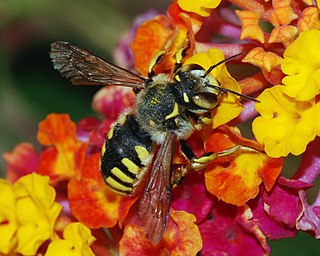
Anthidium is a genus of bees often called carder or potter bees, who use conifer resin, plant hairs, mud, or a mix of them to build nests. They are in the family Megachilidae which is cosmopolitan in distribution and made up of species that are mostly solitary bees with pollen-carrying scopa that are only located on the ventral surface of the abdomen. Other bee families have the pollen-carrying structures on the hind legs. Typically species of Anthidium feed their brood on pollen and nectar from plants. Anthidium florentinum bees are distinguished from most of its relatives by yellow or brick-red thoracic bands. They fly all summer and make the nests in holes in the ground, walls or trees, with hairs plucked from plants.
Heinrich Friese was a German biologist and entomologist, specialist of bees (melittologist). Between 1883 and 1939 he described 1,989 new species and 564 new varieties or subspecies of insects, 99% of which were bees.
Anthidium taeniatum is a species of bee in the family Megachilidae, the leaf-cutter, carder, or mason bees.
Anthidium spiniventre is a species of bee in the family Megachilidae, the leaf-cutter, carder, or mason bees.
Anthidium severini is a species of bee in the family Megachilidae, the leaf-cutter, carder, or mason bees.
Anthidium septemspinosum is a species of bee in the family Megachilidae, the leaf-cutter, carder, or mason bees.
Anthidium rubripes is a species of bee in the family Megachilidae, the leaf-cutter, carder, or mason bees.
Anthidium pulchellum is a species of bee in the family Megachilidae, the leaf-cutter, carder, or mason bees.

Anthidium oblongatum is a species of bee in the family Megachilidae, the leaf-cutter, carder, or mason bees.
Anthidium montanum is a species of bee in the family Megachilidae, the leaf-cutter, carder, or mason bees.
Anthidium latum is a species of bee in the family Megachilidae, the leaf-cutter, carder, or mason bees.
Anthidium garleppi is a species of bee in the family Megachilidae, the leaf-cutter, carder, or mason bees.
Anthidium funereum is a species of bee in the family Megachilidae, the leaf-cutter, carder, or mason bees.
Anthidium emarginatum is a species of bee in the family Megachilidae, the leaf-cutter, carder, or mason bees.
Anthidium diadema is a species of bee in the family Megachilidae, the leaf-cutter, carder, or mason bees.
Anthidium echinatum is a species of bee in the family Megachilidae, the leaf-cutter, carder, or mason bees.
Anthidium collectum is a species of bee in the family Megachilidae, the leaf-cutter, carder, or mason bees.

Anthidium auritum is a species of bee in the family Megachilidae, the leaf-cutter, carder, or mason bees.
Anthidium atricaudum is a species of bee in the family Megachilidae, the leaf-cutter, carder, or mason bees.
Anthidium tesselatum is a species of bee in the family Megachilidae, the leaf-cutter, carder, or mason bees.


